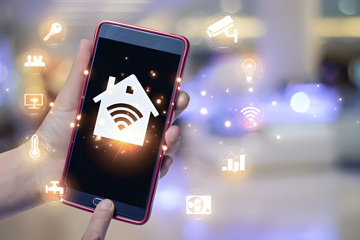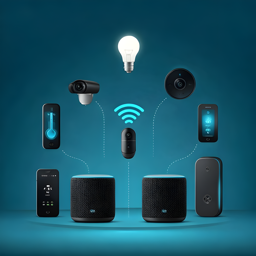Secure ESP32 IoT: HTTPS, MQTT, and Network Hardening
Real-Time IoT Monitoring with ESP32 and Grafana Dashboards
Real-time data visualization is critical for monitoring IoT deployments, debugging systems, and making data-driven decisions. Grafana, an open-source analytics platform, excels at turning raw ESP32 sensor data into actionable insights through customizable dashboards. This guide combines hardware setup, data pipelines, visualization techniques, and optimization strategies Cost Analysis: Total Ownership for ESP32 Connectivity SolutionsUnlock cost savings with ESP32 IoT solutions. This guide reveals how to balance hardware, connectivity, power, and maintenance costs to master TCO. to help you build scalable, secure, and intuitive monitoring solutions.
Cost Analysis: Total Ownership for ESP32 Connectivity SolutionsUnlock cost savings with ESP32 IoT solutions. This guide reveals how to balance hardware, connectivity, power, and maintenance costs to master TCO. to help you build scalable, secure, and intuitive monitoring solutions.
Table of Contents🔗
- Prerequisites: ESP32
 Setting Up ESP32 as a Wi-Fi Access PointMaster ESP32 AP configuration with our step-by-step guide. Set up a secure, local IoT network using practical code examples and optimization tips., Data Pipeline, and Grafana Setup
Setting Up ESP32 as a Wi-Fi Access PointMaster ESP32 AP configuration with our step-by-step guide. Set up a secure, local IoT network using practical code examples and optimization tips., Data Pipeline, and Grafana Setup - Data Flow Architecture: ESP32
 Setting Up ESP32 as a Wi-Fi Access PointMaster ESP32 AP configuration with our step-by-step guide. Set up a secure, local IoT network using practical code examples and optimization tips. → MQTT → InfluxDB → Grafana
Setting Up ESP32 as a Wi-Fi Access PointMaster ESP32 AP configuration with our step-by-step guide. Set up a secure, local IoT network using practical code examples and optimization tips. → MQTT → InfluxDB → Grafana - Sending Sensor Data
 Sigfox Message Encoding: Packing Sensor Data into 12-byte PayloadsLearn efficient data encoding techniques for Sigfox's constrained 12-byte payloads. Discover bitwise operations, structured encoding & CBOR strategies. from ESP32 via MQTT with TLS
Sigfox Message Encoding: Packing Sensor Data into 12-byte PayloadsLearn efficient data encoding techniques for Sigfox's constrained 12-byte payloads. Discover bitwise operations, structured encoding & CBOR strategies. from ESP32 via MQTT with TLS - Storing ESP32
 Setting Up ESP32 as a Wi-Fi Access PointMaster ESP32 AP configuration with our step-by-step guide. Set up a secure, local IoT network using practical code examples and optimization tips. Data in InfluxDB
Setting Up ESP32 as a Wi-Fi Access PointMaster ESP32 AP configuration with our step-by-step guide. Set up a secure, local IoT network using practical code examples and optimization tips. Data in InfluxDB - Configuring Grafana for Real-Time Visualization
- Building a Grafana Dashboard: Panels, Queries, and Templating
- Advanced Visualizations: Heatmaps, Histograms, and Annotations
- Setting Up Alerts for Threshold Crossings
- Optimizing Grafana for High-Data-Rate Deployments
- Case Study: Solar-Powered ESP32 Weather Station
 Connecting ESP32 to Cloud Services via Wi-FiDiscover how to connect your ESP32 to AWS, Azure, and Google Cloud using secure Wi-Fi. This guide covers setup, error handling, and low power strategies.
Connecting ESP32 to Cloud Services via Wi-FiDiscover how to connect your ESP32 to AWS, Azure, and Google Cloud using secure Wi-Fi. This guide covers setup, error handling, and low power strategies. - Tips and Best Practices
 Zigbee Green Power: Ultra-Low-Power Energy Harvesting SolutionsDiscover how ZGP enables battery-free IoT devices through energy harvesting with ESP32 integrations, supporting smart home and industrial applications.
Zigbee Green Power: Ultra-Low-Power Energy Harvesting SolutionsDiscover how ZGP enables battery-free IoT devices through energy harvesting with ESP32 integrations, supporting smart home and industrial applications.
Prerequisites: ESP32, Data Pipeline, and Grafana Setup🔗
Hardware/Software Requirements:
- ESP32
 Setting Up ESP32 as a Wi-Fi Access PointMaster ESP32 AP configuration with our step-by-step guide. Set up a secure, local IoT network using practical code examples and optimization tips. with sensor (e.g., BME280 for temperature/humidity)
Setting Up ESP32 as a Wi-Fi Access PointMaster ESP32 AP configuration with our step-by-step guide. Set up a secure, local IoT network using practical code examples and optimization tips. with sensor (e.g., BME280 for temperature/humidity) - Mosquitto MQTT broker
 Connecting ESP32 to Cloud Services via Wi-FiDiscover how to connect your ESP32 to AWS, Azure, and Google Cloud using secure Wi-Fi. This guide covers setup, error handling, and low power strategies. (local or cloud-based)
Connecting ESP32 to Cloud Services via Wi-FiDiscover how to connect your ESP32 to AWS, Azure, and Google Cloud using secure Wi-Fi. This guide covers setup, error handling, and low power strategies. (local or cloud-based) - InfluxDB v2.4+ (time-series database)
- Grafana v9.0+ (hosted or local instance)
Libraries:
- ESP32
 Setting Up ESP32 as a Wi-Fi Access PointMaster ESP32 AP configuration with our step-by-step guide. Set up a secure, local IoT network using practical code examples and optimization tips.:
Setting Up ESP32 as a Wi-Fi Access PointMaster ESP32 AP configuration with our step-by-step guide. Set up a secure, local IoT network using practical code examples and optimization tips.: PubSubClientfor MQTT Connecting ESP32 to Cloud Services via Wi-FiDiscover how to connect your ESP32 to AWS, Azure, and Google Cloud using secure Wi-Fi. This guide covers setup, error handling, and low power strategies.,
Connecting ESP32 to Cloud Services via Wi-FiDiscover how to connect your ESP32 to AWS, Azure, and Google Cloud using secure Wi-Fi. This guide covers setup, error handling, and low power strategies., ArduinoJsonfor payloads - InfluxDB:
influxdb-client-cppfor C++ integration
Data Flow Architecture: ESP32 → MQTT → InfluxDB → Grafana🔗
ESP32 Sensors → (MQTT over Wi-Fi) → Mosquitto Broker → (Telegraf) → InfluxDB → (Grafana Data Source) → Dashboard
Key Considerations:
- Latency: Use MQTT
 Connecting ESP32 to Cloud Services via Wi-FiDiscover how to connect your ESP32 to AWS, Azure, and Google Cloud using secure Wi-Fi. This guide covers setup, error handling, and low power strategies. QoS 1 to balance speed and reliability.
Connecting ESP32 to Cloud Services via Wi-FiDiscover how to connect your ESP32 to AWS, Azure, and Google Cloud using secure Wi-Fi. This guide covers setup, error handling, and low power strategies. QoS 1 to balance speed and reliability. - Scalability: Implement InfluxDB retention policies to manage storage.
- Security: Enable TLS encryption
 Connecting ESP32 to Cloud Services via Wi-FiDiscover how to connect your ESP32 to AWS, Azure, and Google Cloud using secure Wi-Fi. This guide covers setup, error handling, and low power strategies. for MQTT and token-based authentication for InfluxDB.
Connecting ESP32 to Cloud Services via Wi-FiDiscover how to connect your ESP32 to AWS, Azure, and Google Cloud using secure Wi-Fi. This guide covers setup, error handling, and low power strategies. for MQTT and token-based authentication for InfluxDB.
Sending Sensor Data from ESP32 via MQTT with TLS🔗
#include <WiFi.h>
#include <PubSubClient.h>
#include <ArduinoJson.h>
const char* ssid = "YOUR_SSID";
const char* password = "YOUR_PASS";
const char* mqtt_server = "mqtt.example.com";
const int mqtt_port = 8883;
WiFiClientSecure espClient;
PubSubClient client(espClient);
void sendData() {
StaticJsonDocument<200> doc;
doc["temp"] = readTemperature(); // Custom sensor function
doc["humidity"] = readHumidity();
char payload[200];
serializeJson(doc, payload);
client.publish("esp32/sensors", payload);
}
void setup() {
espClient.setCACert(root_ca); // Add CA certificate for TLS
client.setServer(mqtt_server, mqtt_port);
// Connect to Wi-Fi and MQTT...
}
- Use dynamic topic naming (e.g.,
esp32). Setting Up ESP32 as a Wi-Fi Access PointMaster ESP32 AP configuration with our step-by-step guide. Set up a secure, local IoT network using practical code examples and optimization tips./{device_id}/sensors
Setting Up ESP32 as a Wi-Fi Access PointMaster ESP32 AP configuration with our step-by-step guide. Set up a secure, local IoT network using practical code examples and optimization tips./{device_id}/sensors - Enable TLS with X.509 certificates
 AWS IoT Core with ESP32: X.509 Certificates and Shadow UpdatesLearn to securely connect ESP32 to AWS IoT Core using X.509 certificates and device shadows, with step-by-step instructions and best practices. or pre-shared keys.
AWS IoT Core with ESP32: X.509 Certificates and Shadow UpdatesLearn to securely connect ESP32 to AWS IoT Core using X.509 certificates and device shadows, with step-by-step instructions and best practices. or pre-shared keys.
Storing ESP32 Data in InfluxDB🔗
1. Create a Bucket:
influx bucket create -n esp32_data --retention 30d
2. Configure Telegraf (MQTT Connecting ESP32 to Cloud Services via Wi-FiDiscover how to connect your ESP32 to AWS, Azure, and Google Cloud using secure Wi-Fi. This guide covers setup, error handling, and low power strategies.-to-InfluxDB bridge):
Connecting ESP32 to Cloud Services via Wi-FiDiscover how to connect your ESP32 to AWS, Azure, and Google Cloud using secure Wi-Fi. This guide covers setup, error handling, and low power strategies.-to-InfluxDB bridge):
[[inputs.mqtt_consumer]]
servers = ["tcp://mqtt.example.com:8883"]
topics = ["esp32/#"]
data_format = "json"
tls_ca = "/etc/telegraf/ca.pem"
[[outputs.influxdb_v2]]
urls = ["http://localhost:8086"]
token = "$INFLUX_TOKEN"
organization = "iot_team"
bucket = "esp32_data"
Configuring Grafana for Real-Time Visualization🔗
1. Add InfluxDB Data Source:
- URL:
http Using Quectel BC66/BG96 Modules with ESP32 for NB-IoT ConnectivityExplore our detailed tutorial on integrating Quectel BC66/BG96 with ESP32 for low-power, reliable NB-IoT connectivity. Learn hardware setup and AT commands.://localhost:8086
Using Quectel BC66/BG96 Modules with ESP32 for NB-IoT ConnectivityExplore our detailed tutorial on integrating Quectel BC66/BG96 with ESP32 for low-power, reliable NB-IoT connectivity. Learn hardware setup and AT commands.://localhost:8086 - Authentication: Use a token with read access to
esp32_data.
2. Enable Alerting: Configure notification channels (e.g., Slack, email).
Building a Grafana Dashboard: Panels, Queries, and Templating🔗
1. Time-Series Panel Example:
from(bucket: "esp32_data")
|> range(start: -15m)
|> filter(fn: (r) => r["_measurement"] == "sensors")
|> filter(fn: (r) => r["_field"] == "temp")
|> aggregateWindow(every: 10s, fn: mean)
2. Templating for Dynamic Dashboards:
- Create a variable
$deviceusingSHOW TAG VALUES WITH KEY = "device_id".
Advanced Visualizations: Heatmaps, Histograms, and Annotations🔗
- Heatmap:
from(bucket: "esp32_data")
|> range(start: -1h)
|> histogram(bins: [0, 25, 30, 35]) // Temperature bins
- Annotations: Trigger events (e.g., maintenance logs) via InfluxDB alerts.
Setting Up Alerts for Threshold Crossings🔗
1. Create Alert Rule:
- Condition:
WHEN last() OF query(A, 1m, now()) > 35
2. Notifications: Send alerts to Slack/email when thresholds are breached.
Optimizing Grafana for High-Data-Rate Deployments🔗
- Downsampling: Use InfluxDB tasks to reduce data granularity:
option task = {name: "downsample_1h", every: 1h}
from(bucket: "esp32_data")
|> aggregateWindow(every: 1h, fn: mean)
|> to(bucket: "esp32_downsampled")
- Caching: Increase Grafana’s
[dashboards]TTL to 10m.
Case Study: Solar-Powered ESP32 Weather Station🔗
Setup:
- 10x ESP32 nodes with BME280 sensors, transmitting via LoRaWAN
 ESP32 Multi-Protocol Gateways: Combining Wi-Fi, BLE, and LoRaDiscover how to build a multi-protocol ESP32 gateway integrating Wi-Fi, BLE, and LoRa for scalable IoT deployments in smart cities and industry..
ESP32 Multi-Protocol Gateways: Combining Wi-Fi, BLE, and LoRaDiscover how to build a multi-protocol ESP32 gateway integrating Wi-Fi, BLE, and LoRa for scalable IoT deployments in smart cities and industry.. - Dashboard panels for battery voltage, signal strength (RSSI), and rainfall alerts.
Results:
- Anomaly detection using
holt_winters()to predict sensor failures. - Heatmaps for correlating solar exposure and sensor performance.
Tips and Best Practices🔗
- Minimize Latency: Use QoS 1 for MQTT
 Connecting ESP32 to Cloud Services via Wi-FiDiscover how to connect your ESP32 to AWS, Azure, and Google Cloud using secure Wi-Fi. This guide covers setup, error handling, and low power strategies. and optimize Telegraf batch intervals.
Connecting ESP32 to Cloud Services via Wi-FiDiscover how to connect your ESP32 to AWS, Azure, and Google Cloud using secure Wi-Fi. This guide covers setup, error handling, and low power strategies. and optimize Telegraf batch intervals. - Data Retention: Apply InfluxDB retention policies to manage storage costs
 Quick Comparison: Range, power consumption, costs, and complexity of each technologyDiscover the ideal wireless solution for your ESP32 IoT project by analyzing range, power, cost, and complexity. Optimize connectivity now..
Quick Comparison: Range, power consumption, costs, and complexity of each technologyDiscover the ideal wireless solution for your ESP32 IoT project by analyzing range, power, cost, and complexity. Optimize connectivity now.. - Security: Always use TLS for MQTT
 Connecting ESP32 to Cloud Services via Wi-FiDiscover how to connect your ESP32 to AWS, Azure, and Google Cloud using secure Wi-Fi. This guide covers setup, error handling, and low power strategies. and secure Grafana with reverse proxies.
Connecting ESP32 to Cloud Services via Wi-FiDiscover how to connect your ESP32 to AWS, Azure, and Google Cloud using secure Wi-Fi. This guide covers setup, error handling, and low power strategies. and secure Grafana with reverse proxies. - Visual Clarity: Use Grafana themes and limit panels to critical metrics.
By integrating ESP32 with Grafana, you can transform raw sensor data Sigfox Message Encoding: Packing Sensor Data into 12-byte PayloadsLearn efficient data encoding techniques for Sigfox's constrained 12-byte payloads. Discover bitwise operations, structured encoding & CBOR strategies. into actionable insights. From setting up secure data pipelines to designing interactive dashboards, this guide provides the tools to build scalable, real-time monitoring solutions for any IoT deployment.
Sigfox Message Encoding: Packing Sensor Data into 12-byte PayloadsLearn efficient data encoding techniques for Sigfox's constrained 12-byte payloads. Discover bitwise operations, structured encoding & CBOR strategies. into actionable insights. From setting up secure data pipelines to designing interactive dashboards, this guide provides the tools to build scalable, real-time monitoring solutions for any IoT deployment.
Author: Marcelo V. Souza - Engenheiro de Sistemas e Entusiasta em IoT e Desenvolvimento de Software, com foco em inovação tecnológica.
References🔗
- Arduino Forum: forum.arduino.cc
- Arduino IDE Official Website: arduino.cc
- ESP-IDF Programming Guide: docs.espressif.com/projects/esp-idf
- ESP32 Arduino Core Documentation: docs.espressif.com/projects/arduino-esp32
- Espressif Documentation: docs.espressif.com
 7 months ago
7 months ago
 7 months ago
7 months ago
 7 months ago
7 months ago
 7 months ago
7 months ago
 7 months ago
7 months ago
 7 months ago
7 months ago
 7 months ago
7 months ago
 8 months ago
8 months ago
 7 months ago
7 months ago
 7 months ago
7 months ago
 7 months ago
7 months ago
 7 months ago
7 months ago
 7 months ago
7 months ago
 7 months ago
7 months ago
 7 months ago
7 months ago
 7 months ago
7 months ago
 7 months ago
7 months ago
 7 months ago
7 months ago
 7 months ago
7 months ago
 7 months ago
7 months ago
 7 months ago
7 months ago
 7 months ago
7 months ago
 7 months ago
7 months ago
 7 months ago
7 months ago
 7 months ago
7 months ago
 7 months ago
7 months ago